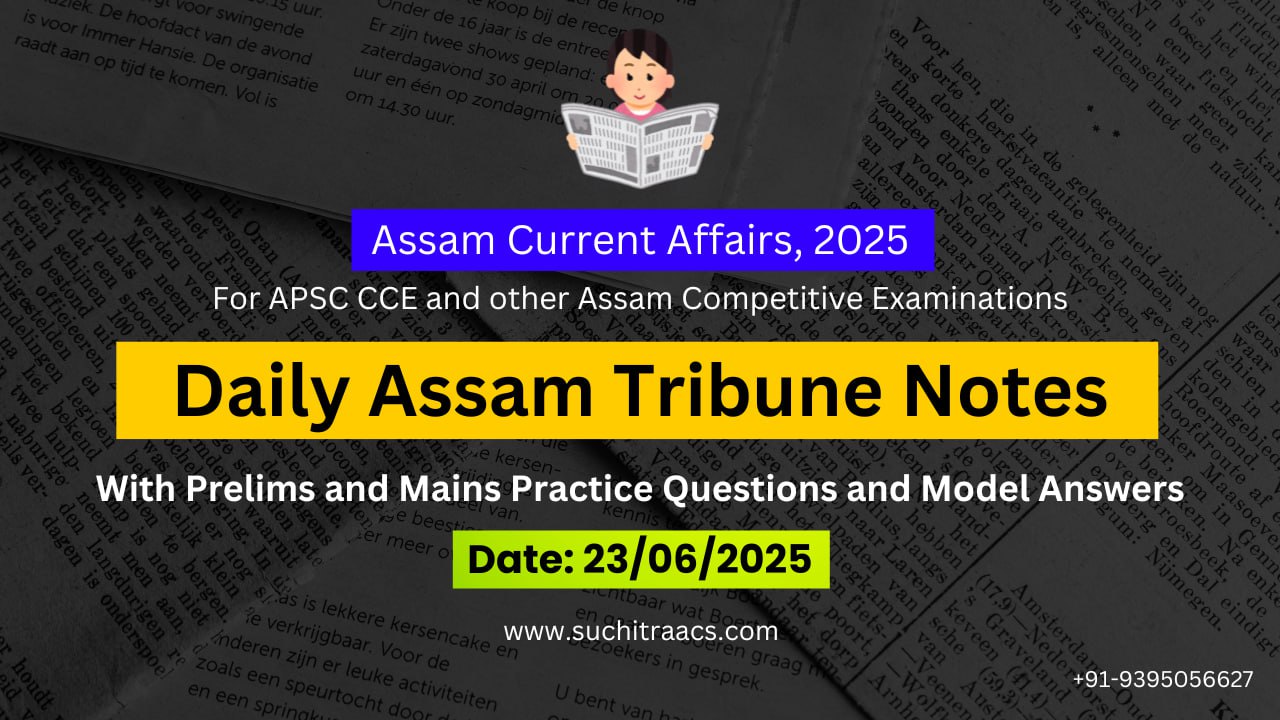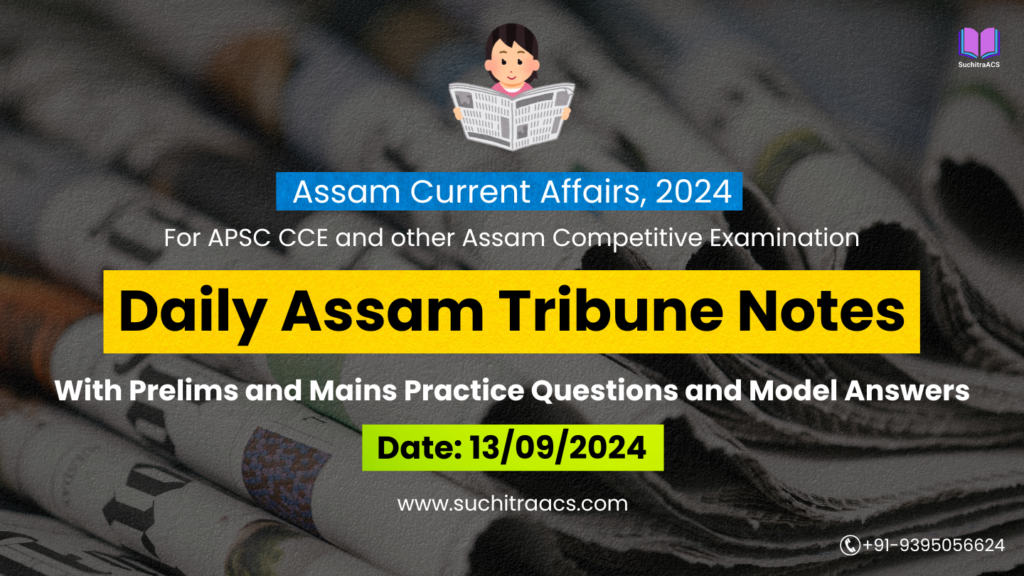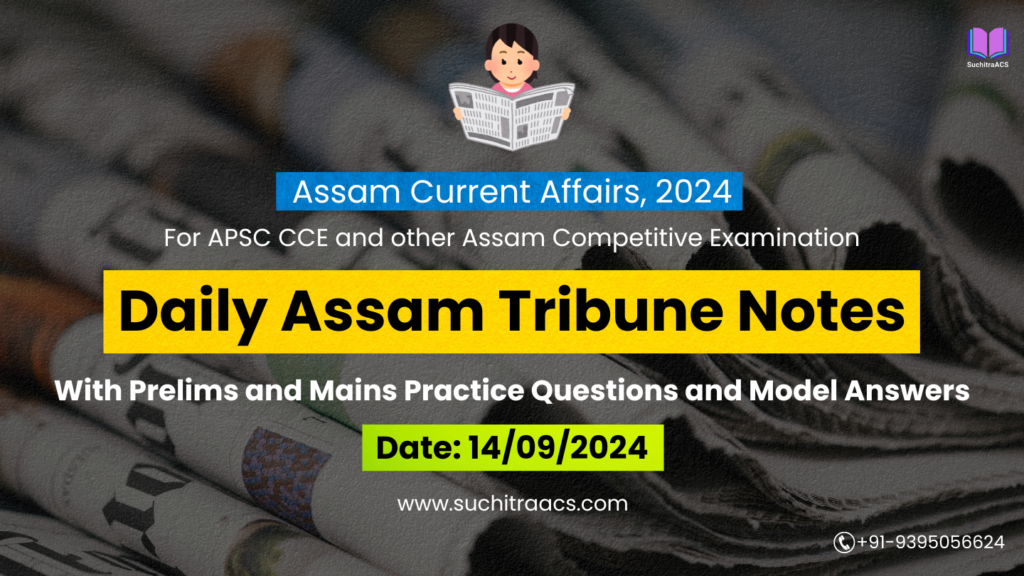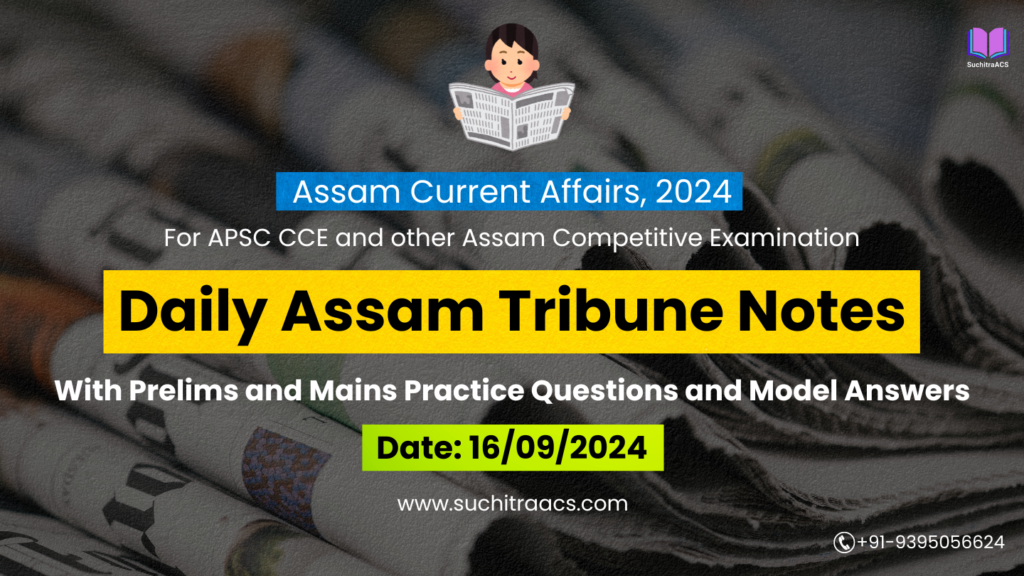APSC Current Affairs: Assam Tribune Notes with MCQs and Answer Writing (23/06/2025)
For APSC CCE and other Assam Competitive examinations aspirants, staying updated with current affairs is vital. This blog covers most important topics from the Assam Tribune today (23-06-2025). These issues are key for both APSC Prelims and Mains preparation, offering insights into the APSC CCE Syllabus.
✨ APSC CCE Online Coaching, 2026

🌿 Cabinet Nod to Proposed Reserve Forest Status for Urpad and Hasila Beels
📘 GS Paper 3: Environment | Biodiversity Conservation | Wetlands
📘 GS Paper 2: Governance – Policies for Vulnerable Ecosystems
📘 GS Paper 5 (APSC): Assam – Environmental Governance | Wetland Conservation
🔹 Introduction
In a significant ecological move, the Assam State Cabinet approved the notification of Urpad Beel (1,256 Ha) in Goalpara and Hasila Beel (245 Ha) as Proposed Reserve Forests (PRFs) under the Assam Forest Regulation, 1891. The initiative aims to enhance wetland protection, prevent encroachments, and conserve biodiversity in these ecologically fragile zones.
🔑 Key Details
| Feature | Description |
| 📍 Location | Goalpara (Urpad), Nalbari (Hasila) |
| 🌊 Type | Seasonal wetlands (Beels) |
| 🏞️ Proposed Area | Urpad Beel – 1,256 hectares; Hasila Beel – 245 hectares |
| 🛡️ Legal Provision | Assam Forest Regulation, 1891 – Section 5 |
| ⏳ Public Hearing Period | 1 month (for objections & claims) |
| 🔎 Ecosystem Value | Habitat for birds, fish, amphibians, aquatic plants |
| 🐦 Migratory Birds Presence | Recognised bird habitat during winters |
| 🧭 Authority Involved | Department of Environment & Forests, Govt. of Assam |
🧠 Prelims Pointers
Beel: A term for lake or large aquatic wetland in Assam
Reserve Forest (RF): A protected forest with restricted access and regulated use
Ramsar Convention: International treaty for wetland conservation (India has 80+ Ramsar sites)
State Wetland Authority, Assam: Oversees wetland mapping, rejuvenation, conservation
Flyways: Assam wetlands fall under the Central Asian Flyway for migratory birds
📝 Mains Pointers
A. Importance of Declaring Beels as Reserve Forests
Legal Protection from encroachment and land conversion
Boosts Biodiversity – sustains fish, birds, and local livelihoods
Ecotourism Potential – controlled tourism for bird-watching and conservation education
Flood Mitigation – acts as natural buffers during monsoon
Climate Regulation – carbon sink, controls microclimate and groundwater recharge
B. Challenges to Wetland Protection in Assam
| Issue | Description |
| 🌾 Agricultural Encroachment | Draining wetlands for farming |
| 🏘️ Unplanned Development | Urbanisation pressures on fringe zones |
| 🗑️ Pollution | Dumping of domestic/agricultural waste |
| 🌊 Siltation | Brahmaputra and tributaries depositing sediments |
| ❌ Policy Implementation | Weak enforcement despite mapping and classification |
C. Government Measures
Wetland Mapping by NESAC & Forest Dept. – Ongoing GIS mapping of ~3,000 beels
Assam Wetland Conservation Rules, 2023 – Notified to regulate use and pollution
Amrit Beel Rejuvenation Scheme – Focuses on eco-restoration and community engagement
Eco-sensitive Zone Notification around wetlands and RFs
Joint Forest Management (JFM) involving local communities in protection
🧭 Way Forward
| Action | Strategy |
| 📜 Final Notification | After 1-month claim period, declare full Reserve Forest |
| 🧑🌾 Community Involvement | Engage local fishers, farmers in wetland stewardship |
| 🐦 Bird Conservation Zones | Seasonal closures and habitat zoning |
| 🧪 Eco-Labelling | Certified biodiversity zones for low-impact ecotourism |
| 📚 Awareness | School-level wetland education programs in Goalpara, Nalbari |
🧩 Conclusion
Declaring Urpad and Hasila Beels as Reserve Forests represents a crucial convergence of ecology, governance, and climate adaptation in Assam. With proper implementation, these beels can be models for community-led wetland protection and sustainable use, especially as Assam grapples with rapid ecological degradation and biodiversity loss.
🇮🇳 India, Bangladesh Finalise Water-Sharing Data-Sharing Mechanism on Teesta & Other Rivers
📘 GS Paper 2: International Relations | India and its Neighbours | Water Diplomacy
📘 GS Paper 1: Geography – River Systems | Inter-State & Cross-Border Rivers
📘 GS Paper 5 (APSC): Assam – Border Relations | Brahmaputra Basin Issues
🔹 Introduction
India and Bangladesh have agreed to revive and institutionalise a long-stalled water-sharing framework, with renewed commitments to data exchange on shared rivers like the Teesta, Dharla, Dudhkumar, and Brahmaputra tributaries. The development comes ahead of PM Sheikh Hasina’s upcoming visit to India and reflects a maturing water diplomacy in the Eastern region.
🔑 Key Details
| Element | Description |
| 🤝 Agreement Type | Technical data-sharing & water flow coordination |
| 🌊 Rivers Involved | Teesta, Dudhkumar, Dharla, Brahmaputra tributaries |
| 🏛️ Institutional Body | India-Bangladesh Joint Rivers Commission (JRC) |
| 📍 Assam’s Role | Key upper-riparian state, especially for Brahmaputra basin |
| 🧭 Geostrategic Context | China’s hydrological projects on upstream Yarlung Tsangpo |
| 📆 Event Timing | Ahead of Sheikh Hasina’s official bilateral visit |
🧠 Prelims Pointers
Teesta River: Originates in Sikkim, flows through West Bengal, into Bangladesh
JRC (Joint Rivers Commission): Set up in 1972 for river-related cooperation
Indo-Bangla Ganga Treaty (1996): Historical example of water-sharing accord
Yarlung Tsangpo: Upper stream of Brahmaputra in Tibet (China); source of regional concern
Brahmaputra: Called Jamuna in Bangladesh; transboundary river with huge flood potential
📝 Mains Pointers
A. Significance of the Move
Reduces geopolitical tension over transboundary river sharing
Enhances flood forecasting and mitigation in Assam and Bengal
Encourages scientific, non-politicised hydrological cooperation
Strengthens India-Bangladesh economic and environmental ties
Counters Chinese influence over upstream data monopoly
B. Issues in India–Bangladesh Water Cooperation
| Issue | Explanation |
| ⚖️ Teesta Accord Delays | Stuck due to West Bengal’s political objections |
| 🌊 Lack of Real-time Data | Poor river discharge info sharing during monsoon |
| 🧱 Dam/Embankment Conflicts | Unilateral constructions affect downstream flows |
| 🚫 Non-binding Frameworks | JRC lacks legal enforcement power |
| 🧑🌾 Farmer Impact | Farmers in Assam and North Bengal face irrigation instability |
C. Assam-Specific Concerns
Flash floods and waterlogging in Barak and Brahmaputra valleys
Cross-border erosion along Dhubri and Karimganj belts
Riverine border disputes aggravated by flow alterations
Need for real-time alerts during upstream water releases from dams
📑 Relevant Policies & Treaties
National Water Policy, 2012 – Principles for inter-state and transboundary cooperation
India’s River Basin Management Bill (draft) – Proposes River Basin Authorities
UN Convention on Transboundary Watercourses – India not a signatory, but relevant
SDG 6 – Clean water and transboundary cooperation
🧭 Way Forward
| Recommendation | Strategy |
| 📊 Hydrological Transparency | Upgrade joint stations to automatic telemetry data-sharing |
| 🧑🔬 Scientific River Boards | Involve IITs, climate bodies in basin-level management |
| 🧑🤝🧑 State Involvement | Include Assam and Bengal in JRC consultations |
| 🛰️ Satellite Monitoring | Real-time remote sensing of catchment changes |
| 🤝 Treaty Finalisation | Expedite Teesta accord based on equitable & sustainable use |
🧩 Conclusion
Water diplomacy with Bangladesh, especially over rivers like Teesta and Brahmaputra, is central to India’s regional security and climate resilience. Assam, being a major upper-riparian player, must be empowered in these dialogues to ensure localised solutions to transnational challenges.
🏥 “ICU on Wheels” Initiative by GMCH: Assam’s Push for Emergency Medical Innovation
📘 GS Paper 2: Health | Government Schemes | Innovations in Public Service
📘 GS Paper 3: Infrastructure – Health | Science & Tech Applications
📘 GS Paper 5 (APSC): Assam – Healthcare Access | Disaster Response | Emergency Services
🔹 Introduction
The Gauhati Medical College and Hospital (GMCH) has launched the state’s first “ICU on Wheels” ambulance service – a mobile intensive care unit equipped with life-support systems, emergency medications, and telemedicine integration. This project is part of Assam’s broader plan to bridge emergency care gaps, especially in remote or accident-prone zones.
🔑 Key Features
| Feature | Details |
| 🚑 Initiative By | GMCH in collaboration with State Health Department |
| 🏥 Functionality | 24×7 mobile critical care service |
| 🛠️ Equipment | Ventilator, defibrillator, oxygen, telemedicine, ECG |
| 🗺️ Target Area | Kamrup Metro & adjoining districts (Phase 1) |
| 🧑⚕️ Medical Staff | Paramedics, critical care nurse, doctor on call |
| 🎯 Objectives | Reduce trauma-related mortality, improve cardiac/stroke outcomes |
🧠 Prelims Pointers
Golden Hour Rule: Critical one-hour window after trauma or cardiac arrest
ALS Ambulance: Advanced Life Support unit, with ICU-grade equipment
Tele-ICU: Virtual monitoring by critical care specialists
eSanjeevani: GoI’s telemedicine platform integrated in several states
GMCH: Premier tertiary care hospital and teaching institute in Northeast India
📝 Mains Pointers
A. Significance of “ICU on Wheels”
Improves access to life-saving care during transit
Reduces burden on urban ICUs by stabilising patients early
Boosts disaster response capability (floods, road accidents)
Symbol of tech-enabled healthcare decentralisation
Serves as pilot for rural mobile ICU expansion in Assam
B. Key Challenges
| Challenge | Description |
| 🚑 Fleet & Coverage Limit | Only 1–2 units in pilot phase; limited reach |
| 🧑⚕️ Skilled Staff Shortage | Trained paramedics & critical care nurses in short supply |
| 🔋 Maintenance Costs | ICU-grade systems require regular calibration |
| 📡 Connectivity Issues | Real-time tele-ICU data requires stable internet |
| 🧾 Operational Sustainability | Long-term funding model unclear (PPP vs state-funded?) |
C. Related Initiatives
108 Emergency Response Services – Basic ambulance model
National Health Mission (NHM) – Support for EMRI and trauma centres
Ayushman Bharat Health Infra Mission – Strengthening critical care blocks
Assam Health Vision 2030 – Targets universal access to emergency and intensive care
NEC & DoNER Grants – Possible funders for expansion in hill districts
🧭 Way Forward
| Area | Recommendation |
| 🚗 Fleet Expansion | One ICU unit per district in Phase 2 |
| 👥 HR Development | Skill paramedics under PMKVY emergency care modules |
| 📶 Tech Backbone | Use satellite connectivity for remote tele-ICU |
| 💰 Public-Private Partnerships | Involve health-tech firms & CSR arms of PSUs |
| 🧮 Monitoring & Evaluation | Real-time dashboard to track deployment & outcomes |
🧩 Conclusion
The “ICU on Wheels” model by GMCH is a game-changer for health equity in Assam, especially where critical care access is time-sensitive. If scaled wisely, it can become a national model of mobile critical care, aligning with India’s vision of universal and inclusive health infrastructure.
APSC Prelims Practice Questions
✅ Topic 1: Reserve Forest Status for Urpad and Hasila Beels
1. What is the primary legal provision used to declare a Proposed Reserve Forest in Assam?
A. Wildlife Protection Act, 1972
B. Forest Conservation Act, 1980
C. Assam Forest Regulation, 1891 ✅
D. Environment Protection Act, 1986
🧠 Explanation:
The Assam government uses Section 5 of the Assam Forest Regulation, 1891 to notify Proposed Reserve Forests (PRFs), as in the case of Urpad and Hasila Beels.
2. Which of the following statements regarding “Beels” is/are correct?
- They are shallow, seasonal or permanent wetlands found primarily in Assam.
- They serve as critical habitats for migratory birds.
- They are protected under the Ramsar Convention if designated.
Select the correct code:
A. 1 and 2 only
B. 2 and 3 only
C. 1 and 3 only
D. 1, 2 and 3 ✅
🧠 Explanation:
All three statements are correct:
- “Beel” is the local term for wetlands/lakes in Assam.
- Some beels are Ramsar-designated (e.g., Deepor Beel).
- They are important ecological zones for birdlife and fisheries.
✅ Topic 2: India–Bangladesh River Cooperation
3. Which of the following rivers are shared between India and Bangladesh?
- Teesta
- Dharla
- Brahmaputra
- Ganga
- Yamuna
Select the correct code:
A. 1, 2, 3 and 4 only ✅
B. 1, 2 and 5 only
C. 3, 4 and 5 only
D. All of the above
🧠 Explanation:
India and Bangladesh share 54 rivers, including Teesta, Dharla, Brahmaputra, and Ganga. Yamuna is not a transboundary river between the two.
4. Which of the following bodies is responsible for bilateral water cooperation between India and Bangladesh?
A. Indus Waters Commission
B. Joint Rivers Commission (JRC) ✅
C. Ganga Water Tribunal
D. Brahmaputra River Board
🧠 Explanation:
The Joint Rivers Commission (JRC) was established in 1972 to handle all matters related to the common rivers between India and Bangladesh.
✅ Topic 3: ICU on Wheels by GMCH
5. The “Golden Hour” in emergency medicine refers to:
A. The first 24 hours after hospital admission
B. The first hour after major trauma or medical emergency ✅
C. The time taken to transfer a patient from ICU
D. The ideal time for medical checkups
🧠 Explanation:
The Golden Hour is the first hour after a traumatic injury or critical medical event (like a heart attack) when prompt medical attention drastically improves survival chances.
6. Which of the following equipment are typically found in an ICU-grade ambulance?
- Ventilator
- ECG Monitor
- Defibrillator
- Dialysis Unit
Select the correct answer:
A. 1, 2 and 3 only ✅
B. 1, 3 and 4 only
C. 2, 3 and 4 only
D. All of the above
🧠 Explanation:
ICU ambulances are equipped with ventilators, ECG monitors, and defibrillators, but not dialysis units, which require complex stationary infrastructure.
APSC Mains Practice Question
📝 Mains Question:
Q. Discuss the significance of India–Bangladesh river cooperation in the context of water security, regional stability, and ecological sustainability. Highlight the strategic role of Assam in such transboundary frameworks.
📘 Model Answer
Introduction
India and Bangladesh share 54 transboundary rivers, including the Teesta, Dharla, Dudhkumar, and Brahmaputra. With growing water stress, climate variability, and ecological degradation, river cooperation between the two neighbours is critical to ensure regional peace, economic development, and environmental protection. The recent revival of a technical data-sharing framework ahead of PM Sheikh Hasina’s visit signals a maturing water diplomacy.
Significance of India–Bangladesh River Cooperation
| Area | Importance |
| Water Security | Ensures equitable flow for agriculture, drinking water, fisheries, etc. |
| Disaster Resilience | Enhances flood forecasting and floodplain zoning |
| Economic Linkages | Boosts river transport, irrigation, power generation |
| Ecological Health | Maintains seasonal flow needed for wetlands, fisheries, and forests |
| Regional Diplomacy | Counters geopolitical tensions and promotes neighbourly trust |
Challenges in Bilateral River Management
| Challenge | Details |
| ⚖️ Teesta Accord Delays | Due to domestic opposition in West Bengal, the deal is stalled since 2011 |
| 📉 Data Sharing Gaps | Lack of real-time hydrological flow data leads to late flood alerts |
| 🛠️ Unilateral Structures | Embankments, barrages alter natural flow without joint planning |
| ⚖️ Asymmetry in Benefits | Bangladesh sees India as an upstream power with more control |
| 🗺️ Fragmented Institutions | Joint Rivers Commission (JRC) lacks legal enforcement powers |
Strategic Role of Assam in the Framework
- Upper-Riparian Stakeholder: Brahmaputra and several tributaries originate or flow through Assam before entering Bangladesh
- Flood-Zone Sensitivity: Assam’s flood control requires upstream and downstream coordination
- Data Hub Potential: Can host real-time telemetry and flood forecasting centres
- Border Security: River disputes often worsen transboundary migration and security threats
- Ecological Interdependence: Beels, wetlands, and forests shared across boundaries (e.g., Kaziranga floodplains)
Way Forward
| Reform Area | Recommendation |
| 🛰️ Data Modernisation | Install automated flow meters with bilateral satellite-based monitoring |
| 👥 Subnational Engagement | Include Assam, West Bengal, and NE states in JRC deliberations |
| 🧑🔬 Science Diplomacy | Set up Joint River Research Centres with IITs, IMD, and hydrology institutes |
| 📜 Legal Framework | Evolve a binding treaty for long-term governance (similar to Indus Waters Treaty) |
| 🌱 Ecosystem Services Valuation | Account for wetland health, biodiversity, and sediment transport in planning |
Conclusion
India–Bangladesh river cooperation must move from political negotiation to institutional partnership. With climate change increasing water volatility, Assam’s strategic and ecological role cannot be sidelined. A robust, science-based, and inclusive river diplomacy will not only safeguard shared water but also foster regional harmony, resilience, and sustainable development.
✨ APSC CCE Courses, 2025-26 offered by SuchitraACS
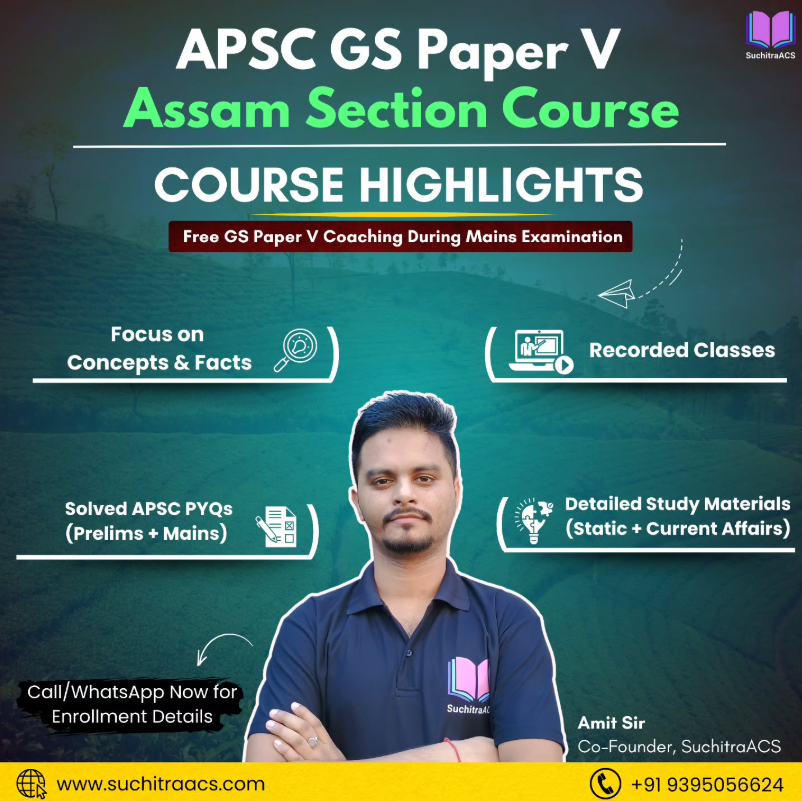

🔔 Join Our WhatsApp Study Group!
For exclusive access to premium quality content, including study materials, current affairs, MCQs, and model answers for APSC CCE and other Assam competitive exams.
Click here to join: SuchitraACS Study WhatsApp Group
📚 Want to know more about SuchitraACS’s most affordable courses?
Click here to know more: SuchitraACS Courses for APSC CCE and Assam Competitive Examinations

